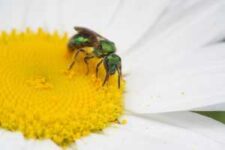
New resource on bees and butterflies available for your garden
Download or print signs about five bees and five butterflies in Michigan.
Flowering plants attract insect-visitors who collect pollen and nectar, feed directly on their stems and leaves, or simply rest on the foliage in between a meal. Michigan’s approximately 460 bee and 135 butterfly species all rely on flowering plants for parts of their life cycle. A caterpillar larvae will feed on the foliage, while a female bee collects pollen for her offspring and sips nectar for energy (Photo 1). Almost every bee and some of these butterflies will help pollinate wildflowers, vegetables and fruits.
Michigan State University Extension created a new resource to highlight the behavior and feature of several common bees and butterflies. The pollinators featured are green sweat bees, yellow-faced bees, squash bees, leafcutter bees, mining bees, ‘Astyanax’ Red-spotted Purple, Red Admiral, Eastern Tiger Swallowtail, Baltimore Checkerspot and Great Spangled Fritillary. Each card includes the size of each pollinator, information about host plants and other facts about the insect. Knowing that a male squash bee sleeps in flowers overnight may not change your gardening practices but shares the story of how pollinators use our gardens in unexpected ways.
Information about each pollinator can be downloaded or printed in their original format and mounted in your garden (Photo 2). Gardeners are encouraged to use these and spread the word about pollinator diversity. Since several pollinators featured in these signs are fast-fliers or hard to notice unless taking a close look within a flower, adding a few pollinator signs in your garden can draw attention to some of the colorful bees that visit your garden.

Though each pollinator has unique requirements for shelter and flower preferences, gardeners can protect pollinators with strategies including planting a variety of shrubs and flowers, avoiding pesticide application on flowering plants, and leaving small areas of the garden undisturbed. Gardeners can visit the Michigan Pollinator Initiative to learn more about creating habitats that support pollinating insects.
View the Common Flower Visitors in Michigan Signs
Did you find this article useful?



